FlexiSpot E7 Pro Plus Standing Desk Review: Sit or Stand
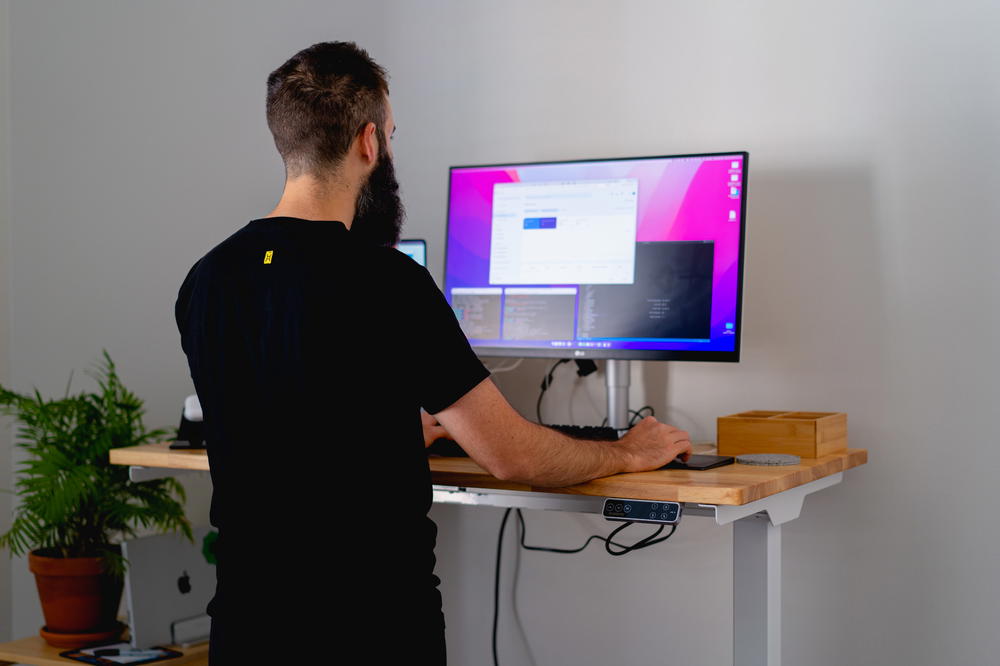
Considering an upscale higher-end standing desk for a home office? I review the FlexiSpot E7 Standing Desk as a height-adjustable hardwood surface desk for working from home.
This article may contain affiliate links. We earn a small commissions when you purchase via those links — and it's free for you. It's only us (Becca & Dan) working on this website, so we value your support! Read our privacy policy and learn more about us.
Ever since I started working from home more regularly, a standing desk has always been my choice of desk.
When I work from home, I find myself sitting for longer periods of time than when I am in an office. It’s really easy to lose track of time when you’re at home, apparently!
Standing desks are my preference because they allow you to have good posture throughout the day and prevent any prolonged effects from sitting for long periods of time.
With so many standing desks on the market, it can be hard (and confusing) to pick the right desk. I’ve been trying out the FlexiSpot E7 standing desk, and in this review, you can find out all about my experience with it.
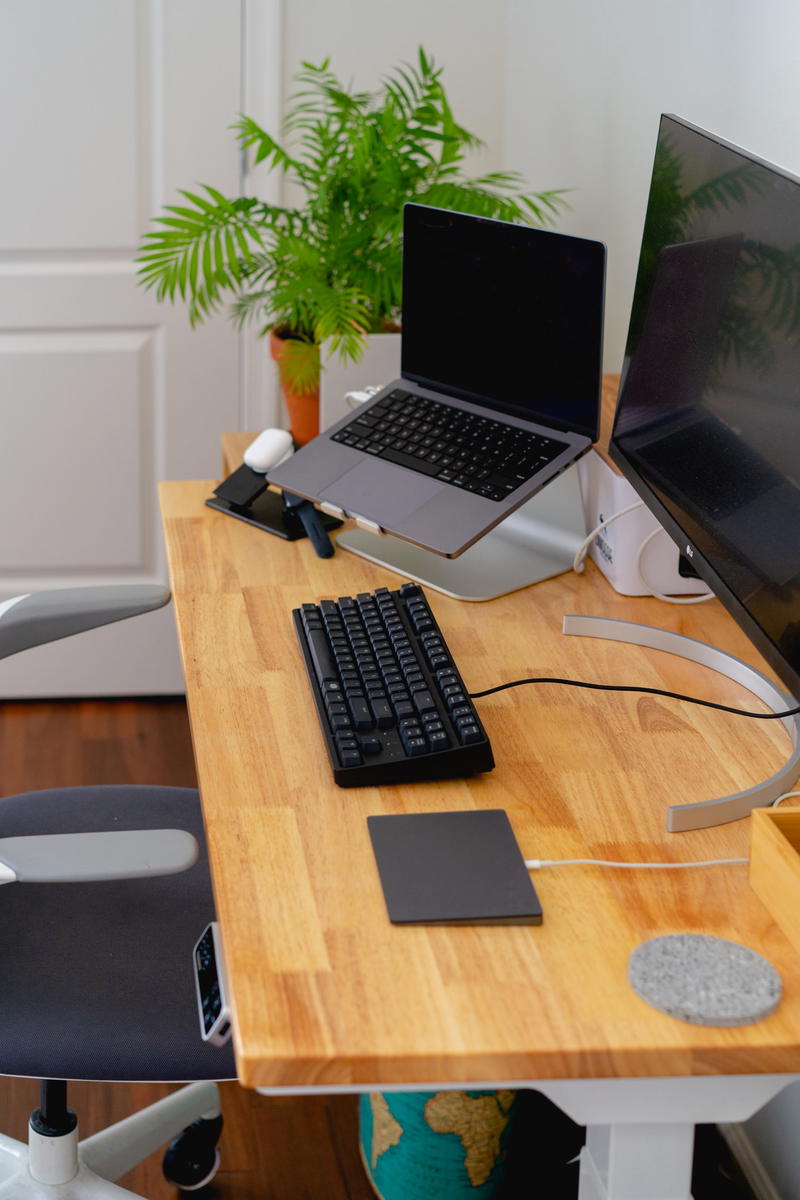
I learned about the FlexiSpot E7 standing desk and reached out to FlexiSpot to give it a try. The company provided me with this desk in order to review it. This article is not sponsored.
FlexiSpot E7 assembly process
The FlexiSpot E7 desk is delivered in two large boxes. The first box will contain the surface that you choose, and the second box will contain all of the desk hardware and components.
Both of these boxes are extremely heavy. Like, really heavy. I was able to carry the table-top box, but I wasn’t able to lift the desk box even a little. We live in an apartment building, and I was finally able to slide it from the elevator into our apartment.
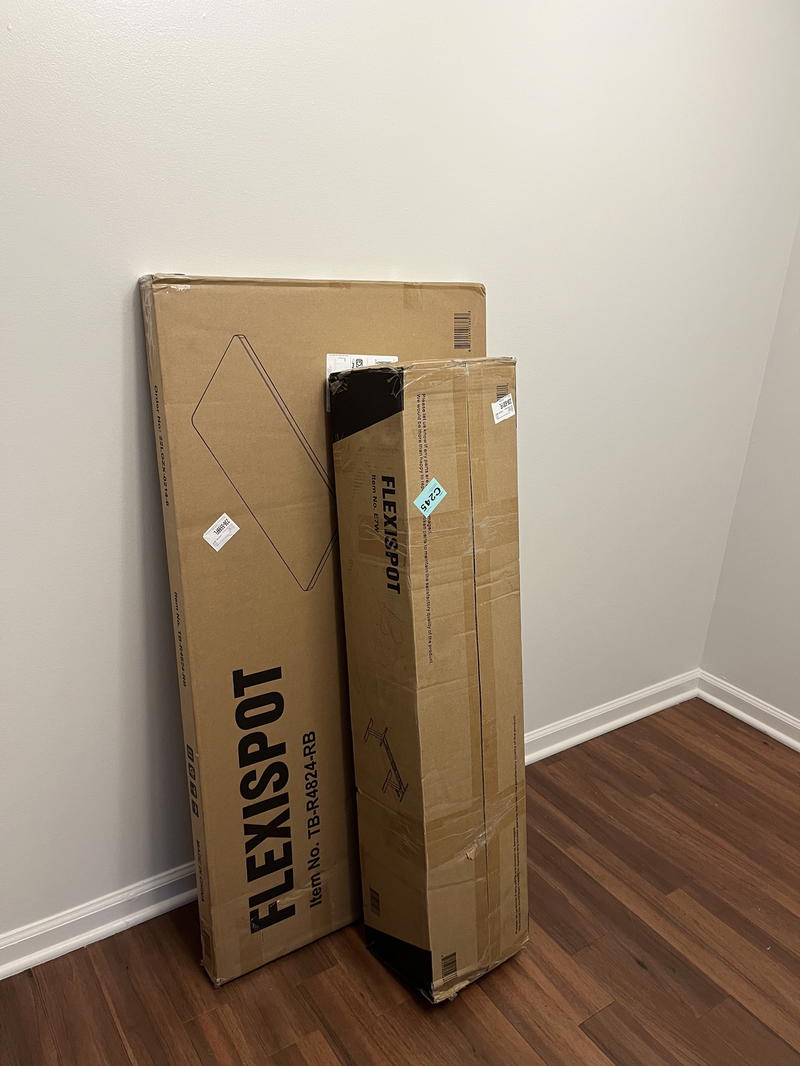
I would highly recommend having someone to help you with assembly when the desk arrives. It would be great if this person could be available when your desk is delivered. And if you’re expecting your desk and you see your UPS or FedEx driver, be very nice to them in advance!
The actual assembly of this standing desk went fairly smoothly. Here is a step-by-step process of how the desk was put together. I’ll call out any special notes that you might want to consider when putting yours together.
When you unbox everything, you’ll notice a very neatly organized box of components. Take out the instructions and follow them carefully.
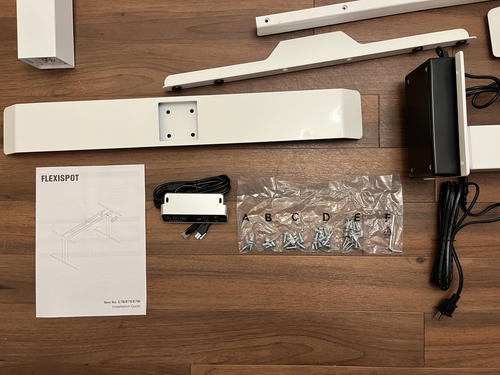
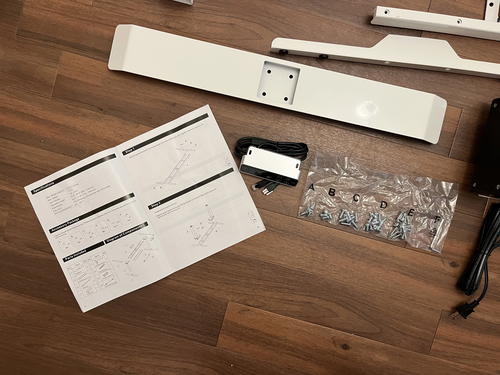
I took everything out of the box and organized the parts so I could access them easily.
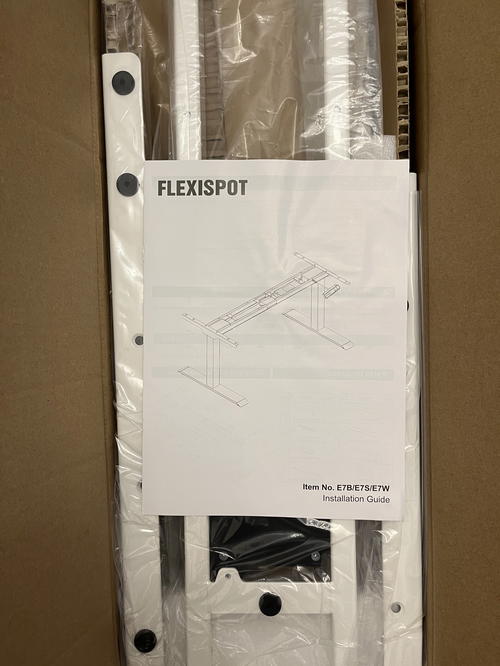
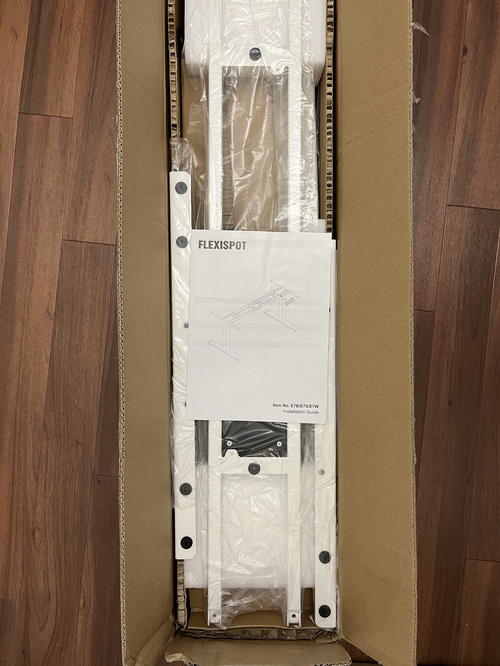
The heaviest pieces are going to be the legs. And that is because that is where the motors live. Each leg has a motor, which makes the desk rise and lower smoothly.
You will start assembling the desk upside down, first.
Because you can get differently sized surfaces, the frame is adjustable to accommodate a wide (pun intended) variety of desk surface widths.
Until this point, I was able to assemble everything on my own. It’s when you need to line up the desk surface to the frame where I had a little trouble and needed some additional help.
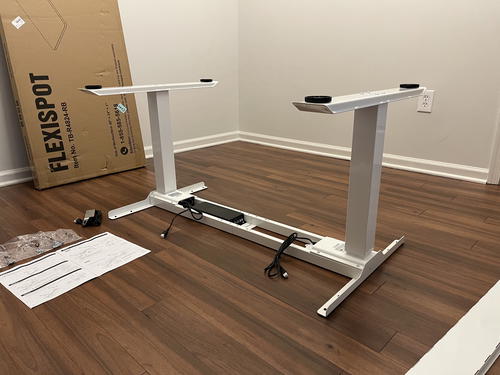
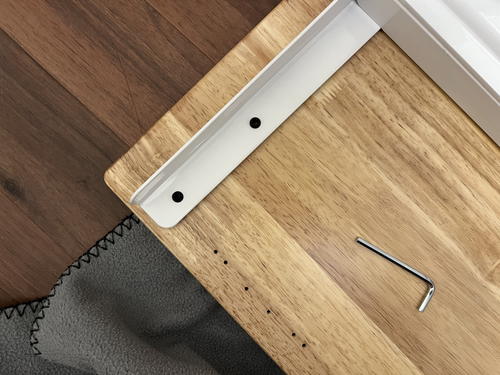
Because the frame is adjustable, it’s really hard to line up the holes only on your own. You need someone on the other side to help slide the ends, and help line everything up. Once everything is aligned, you can tighten the frame and start screwing the surface to the frame.
I initially tried this step purposely upside down because I wanted to do it myself. Don’t do this. It won’t work! Or, it will be really hard to line everything up upside down where you can’t easily see where the frame meets the desk top.
You may also want to assemble the desk on a carpet. Avoid a hardwood floor. Because some of the frame moves around during assembly, you will want to protect your floors if you can.
Screwing the frame into the desk surface was simple. You don’t need any power tools, and you only need a single screwdriver to drive the screws into the surface. The instructions told me I should screw in additional screws into the desk surface when there weren’t any pilot holes. I didn’t do this, and I only put screws in where pilot holes existed.
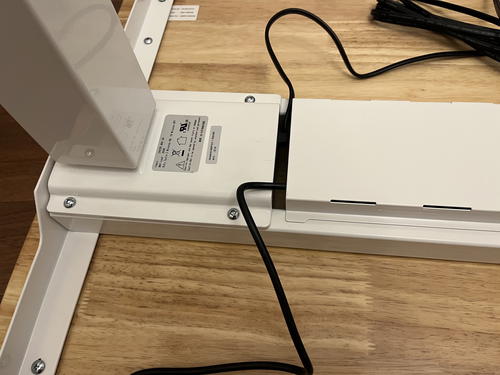
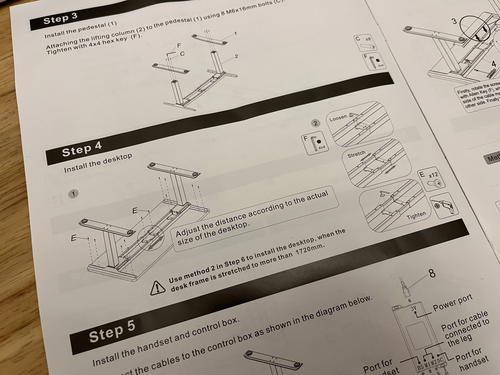
The last step is to flip the desk upright and plug it into a wall!
You’ll probably want someone to help you spin the desk around. Remember: it’s very heavy, so be careful, and don’t strain your back trying to twist and flip! This is also where a carpet or rug might be helpful because this step has a high likelihood of scratching the floor, or even damaging your desk surface.
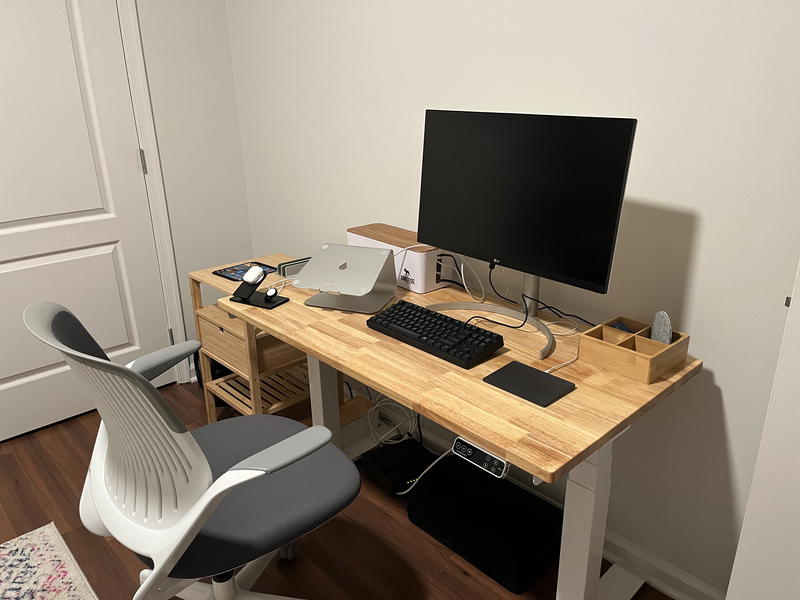
First impressions
The minute I plugged in the desk for the first time, I knew this desk was high quality. The dual motors make a huge difference in the experience of using it, especially when compared to the single-motor Comhar desk, also from FlexiSpot.
In comparison, the E7’s ability to convert into the stand position is smoother and quieter than the Comhar desk. You can read the FlexiSpot Comhar review here!
The solid wood option that I chose is beautiful. It’s the Rubberwood option, by the way. It is much higher quality than the IKEA surface that I was using before!
You can program some shortcuts, which make transitioning between sitting and standing a breeze.
I haven’t noticed any wobbling during my time working. The sitting and standing positions have lots of stability.
Overall, I am really impressed by the quality and how easy the desk was to assemble. I’ll go into much more detail about each feature and some shortcomings down below.
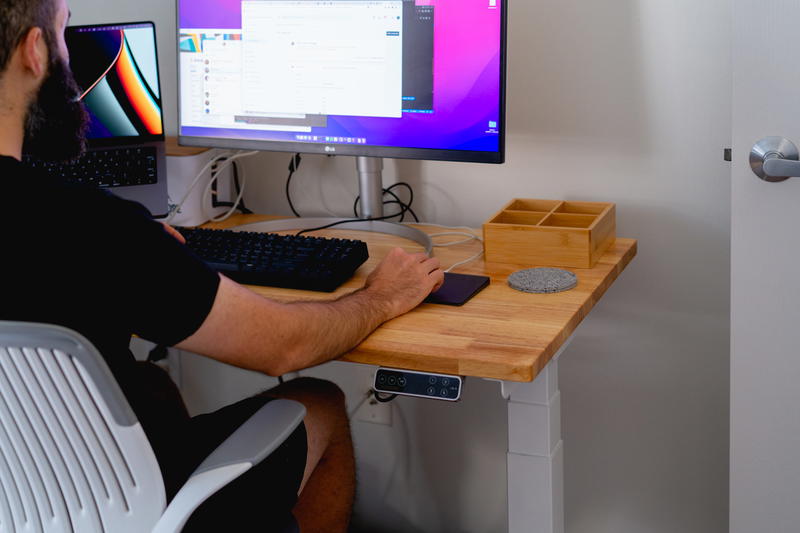
Overview of features
First of all, if you want specific tech specs, visit the E7’s landing page to get that information. I’ll give more of a high-level view of what each feature is, and my opinions about them.
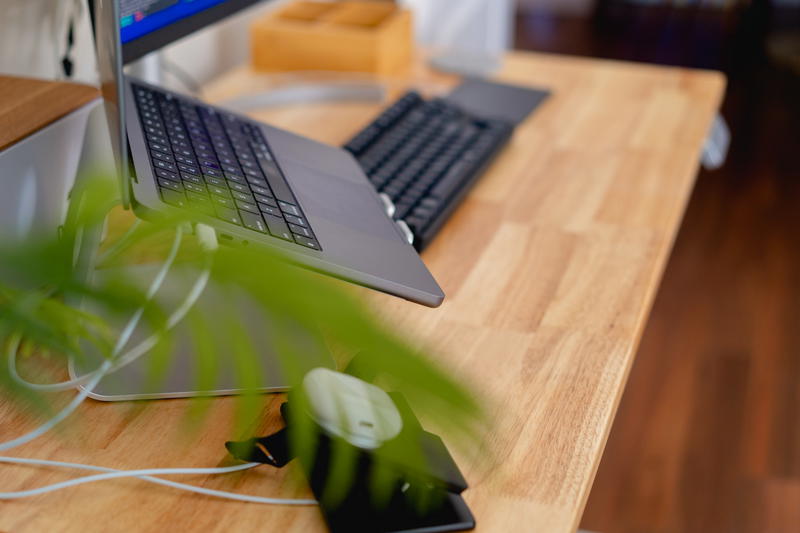
Dual motor
The dual motor makes the desk convert from sitting to standing, and back from standing to sitting, really quickly and effortlessly. This isn’t really a feature you think you need, but if you keep a lot of weight on your desk, you’ll be glad you have it.
As I mentioned in the “first impressions” section, the dual motor is nice because it keeps the conversion process smooth and quiet.
I don’t think this should ultimately be a deciding factor between this desk and other standing desks, but I am glad to have it!

Adjustability
I chose the 48”x24” version with the standard height frame. The desk lowers farther than I would like to sit and can be raised higher than I would like to stand. I’m a pretty average height of 5’9,” so I don’t typically have any problems with things being too short or too tall for me.
Being able to lower the desk farther than you’d like to sit is a bonus if you have small children who might want to use this as a desk for arts and crafts or anything else.
If you are on the taller side, consider some of the higher frame styles to get the most out of your standing experience.
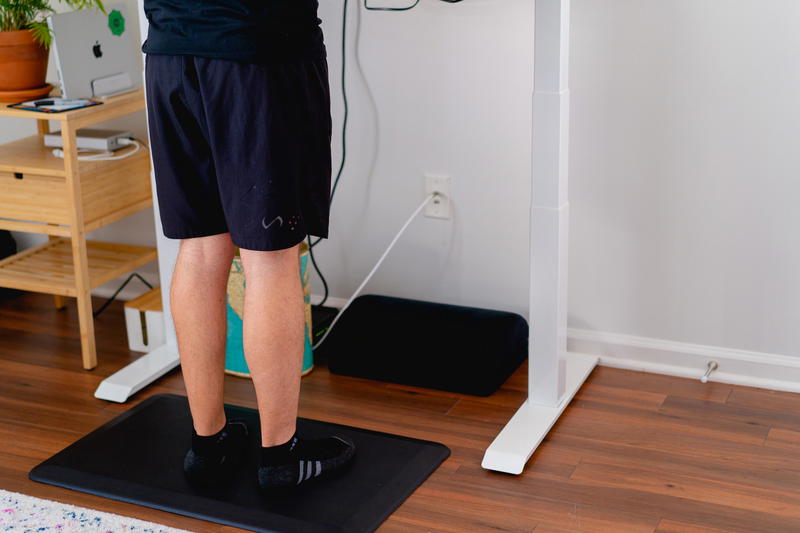
Looking at the width, you can get the 48”x24” (which I have) or the 55”x28” variation. 55” is way too wide for me, and too big for where I wanted to put the desk. There was a time when I had something like a 63”x31” desk, and it was huge. I had plenty of room for an iPad, monitor, laptop, books, pens, paper, coffee, water and the list keeps going.
If I had the space for it, the 55”x28” would be my choice.
I initially struggled with the assembly because the frame accommodates both of the desk surface options.
Lastly, if you have uneven floors, the legs on the desk frame have tiny feet that can be adjusted to give you a perfectly aligned desktop surface.

Weight capacity
The FlexiSpot E7 desk is the FlexiSpot desk that can hold the most weight. FlexiSpot claims that the desk can hold 355 pounds! If I wanted to, I could sit on the desk and work and still have some weight to spare.
This desk is perfect for people with heavy home office setups or people who want peace of mind in having the most stable desk out there.
I don’t have a particularly heavy desk setup, but I like the flexibility of having a desk that can evolve with my working layout and preference.
I have a laptop stand with a MacBook Pro and a single 27” monitor from LG. Again, it’s not the heaviest of home office setup configurations, but if I were to add a second monitor and some other accessories, the weight could really start to add up.
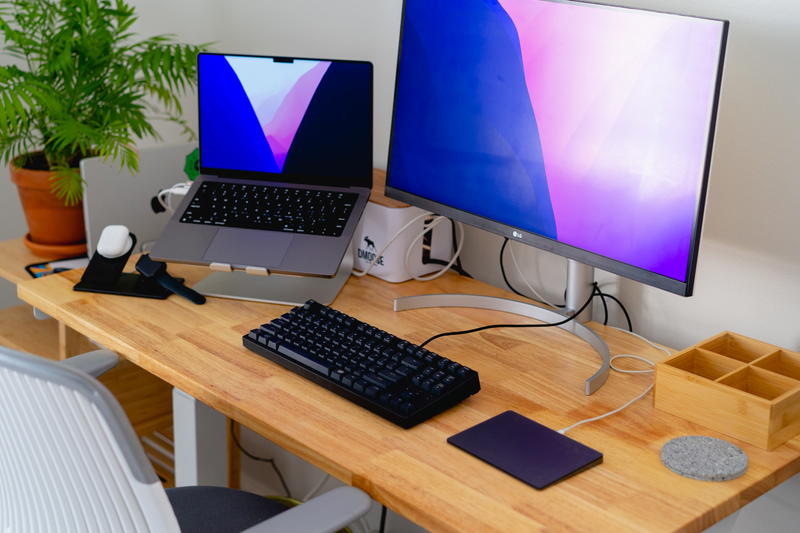
Keypad
The customizable keypad on the E7 standing desk is really simple and straightforward to use. It comes with an additional USB port, which is nice. I have other desk accessories for charging and haven’t used the USB port on the keypad.
One of the first things that I did was find my preferred sitting position and standing position so that I could customize these settings. The instructions that come with the desk show you how to do this.
If you have multiple people using this desk, you can program two additional customizable heights.
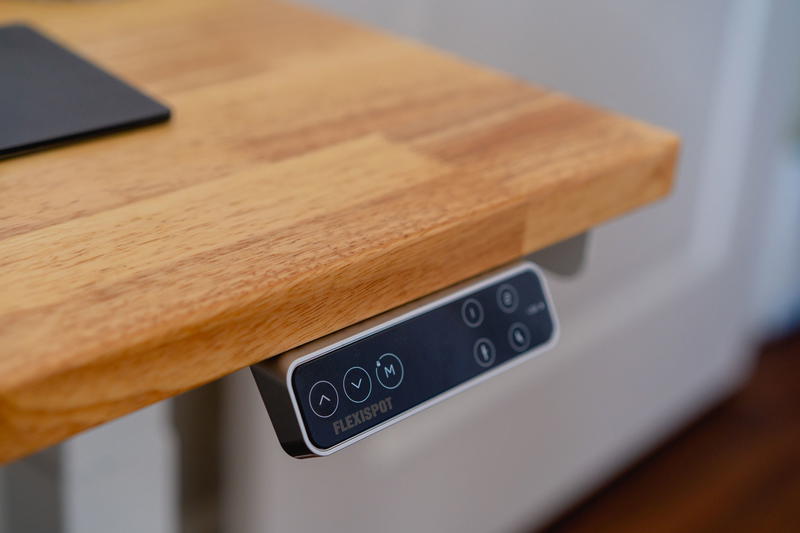
Cable management
One of the features of this desk is a “cable management tray.” It’s fine. I’m neutral about it. On its own, the desk doesn’t do a great job of cable management, but this is one of the biggest general home office improvements that I know of.
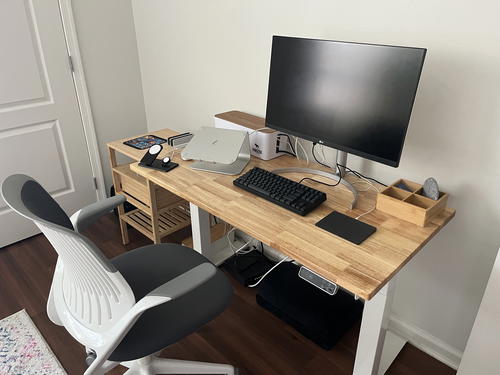
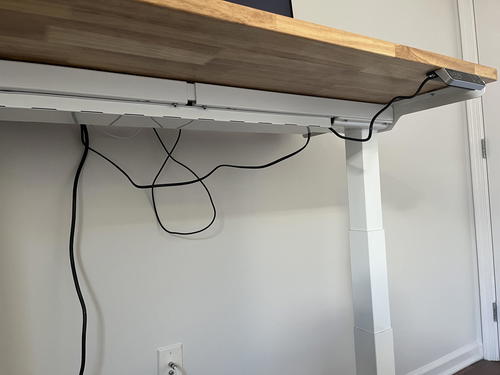
You need to put in some additional effort in order to get the cables nicely organized. Also, keep in mind that when the desk is in the standing position, all of your flaws with poor cable management have nowhere to hide. At least, that was the case with my initial setup.
There are some things that you can do to spruce up the cable management.
- These velcro strips will help group your cables together.
- This cable management box helps keep all of your power in one spot. I’ve been using it for years and like it a lot.
- Consider looking into taping some of the cables under your desk and out of the day. I haven’t done this yet!
Summary of my favorite features of the FlexiSpot E7
Here’s a quick list of my favorite features about the E7 desk.
- Easy to put together
- Beautiful desk surface options
- Smooth transition between the sitting and standing
- Stable work surface
- Quality materials
The E7, and most products from FlexiSpot, are easy to assemble without requiring any specialized tools. The assembly process was easy and took me probably about 35-45 minutes. I spent the most time trying to put the desk together upside down before asking for help and doing it the right way.
The Rubberwood desktop is one of the nicest desk surfaces that I’ve worked on. It elevates your work experience because you know that you have a high-quality material to work on. There is a high attention to detail with how some of the corners are rounded. It’s great!
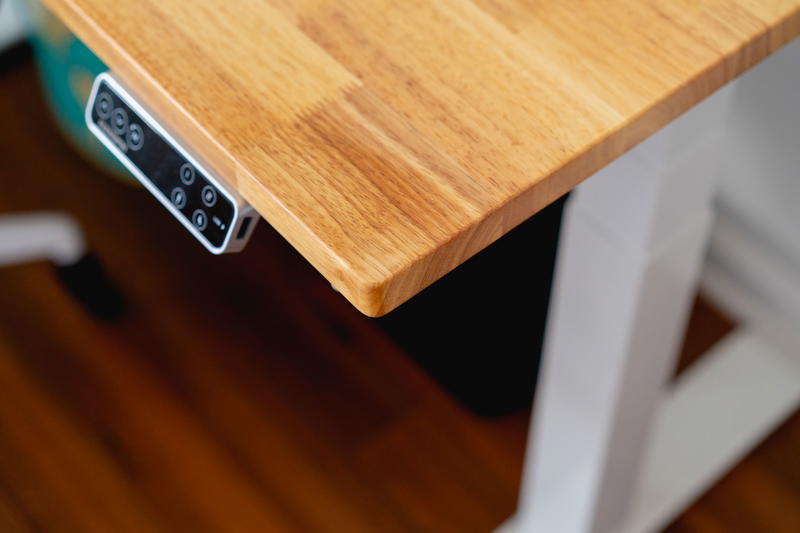
I’ve had no trouble raising the desk to stand and work, and lowering it again to sit. Apparently, there is some protection mechanism that will make the desk stop if there is an obstruction. This is useful if your chair or something else is stuck under the desk while it’s lowering.
When I had my manual standing desk, I would often lower it onto the arm of a desk chair and it would put a lot of tension between the two things.
I have so much stability for everything I use for working (maybe even a little too much)! Whether I am sitting or standing, my monitor doesn’t wobble, and I have 100% confidence that my E7 standing desk can support whatever I put on it.

Summary of things I didn’t like about the E7
Here’s a quick list of some features that I’m not a huge fan of.
- The cable management tray
- The desk surface doesn’t extend past the legs
When I was putting the desk together, I struggled a little bit with the cable tray. It’s attached by the edges of the screws, and there’s no clip or first-party screw that keeps it together. It hasn’t fallen off, but I found that a little odd.
Cable management, in general, is especially hard with standing desks. This isn’t a fault to the E7, but more of something you need to figure out when you have any type of standing desk.
I found that the best way to fix this is to have one cable box and plug that one box into the wall. That way, you only have one cable being raised and lowered, instead of many different things plugged in.
One last little piece of feedback is that the desk legs stick out more than the desk surface. This isn’t a huge deal, but it means that the edge of the desk doesn’t sit flush with my wall. This might bother some consumers.
You don’t want the desk hitting the wall when you raise or lower it, but the wall’s baseboard, in addition to the position of the legs, has the desk about an inch or two farther away from the wall than I would have normally liked.
Is the FlexiSpot E7 right for you?
If you’re looking for a high-end quality desk, then yes: the FlexiSpot E7 is a solid choice of a standing desk this year. Get this desk if you have a generous budget to invest in home office products. This desk is for anyone who needs a multipurpose standing desk surface that can be flexible, efficient and high in quality.
You can load up on monitors, speakers and other heavy equipment on top of this desk, having full confidence that your standing desk can support the weight. To explore more details about this desk on the FlexiSpot website, see all the specs here.
Don’t get this desk if you can’t afford it. FlexiSpot has other desks that might be more within the price that you want to pay.
If you have more of a lightweight desk setup, like maybe only a laptop and something to take notes with, then maybe consider another desk. Becca has the Comhar desk from FlexiSpot and it’s absolutely perfect for her. It has everything she could ask for in a standing desk at a more affordable price point.
We’d like to thank Flexispot for providing us with the E7 Desk; while Flexispot sent us the product as a gift, all thoughts in this review are our own and this piece is not sponsored.

